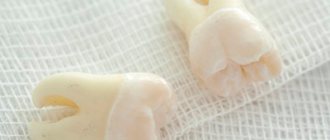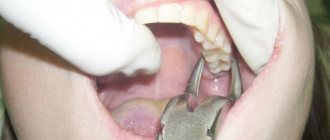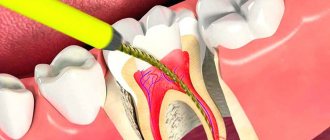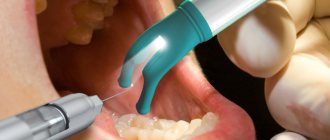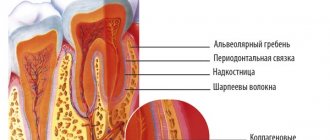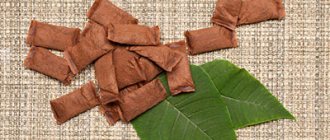The inlay is a one-piece structure, the lower part of which is similar to a stump (therefore a stump). It takes into account the characteristics of the destroyed tooth, so it can be single, double or triple. In complex cases, it may consist of individual elements. The upper part is made of any shape, in accordance with the impression taken. The inlay can be installed without a crown, completely repeating the shape of the tooth. Such microprosthetics are often used in orthopedic dentistry, because even a severely damaged tooth can be completely restored, obtaining an aesthetic dental unit.
Advantages and disadvantages of tabs
- There is no danger of destruction or cracking - the strength and reliability of the inlays is high.
- Resistance to food dyes, color stability.
- The characteristics of the bite are taken into account.
- The shape of the tooth is completely restored and remains unchanged in the future.
- There are no unpleasant sensations at all.
- The result of tooth restoration is highly aesthetic.
- The possibility of the spread of harmful organisms is eliminated.
Negative aspects may arise if you go to clinics with insufficient equipment or inflated prices. In these cases, patients note the lengthy process of manufacturing and installing the inlay and the high cost.
Characteristic signs of unsatisfactory preparation for prosthetics
The official statistics on poorly performed fillings are depressing: in more than half of the cases, the canal is not filled well enough. How to understand that the tooth under the crown is inflamed?
- I feel pain . This is the very first sign that an abscess has formed in the area of the upper part of the root. The pus presses on the surrounding tissues, so the person feels pain. If the inflammatory process has become chronic, then there may be no constant pain, but discomfort when biting will still persist.
- Gums become swollen, flux appears. Sometimes, with purulent inflammation, the tooth even becomes mobile.
- A fistula appears. A hole in the gum occurs during acute inflammation, which is accompanied by severe swelling of the gums. The abscess contains pus: its amount can increase significantly with a decrease in immunity (this can be seen by a very swollen cheek, increased temperature). Purulent formations try to find a way out: breaking through the mucous membrane and bone, they form a hole. This is how a fistula appears - a small passage in diameter that connects the source of pus formation with the oral cavity. Through this hole, pus enters the mouth, and from there, along with food, into the stomach. As the pus comes out, the inflammatory process subsides. Sometimes the fistula can completely heal, but then the inflammatory process begins to increase again.
- Cyst – This is the extreme stage of the development of periodontitis. It looks like a cavity in the bone, covered from the inside with a fibrous membrane that contains pus.
Any of the above symptoms is a reason to make an appointment with a dentist, and the sooner this is done, the better. First of all, the doctor will send the patient for an x-ray: from the image it will be possible to determine what is the cause of the pain under the crown. It is useless to hope that the pain will go away on its own or to try to drown it out with pills: the only correct option is a visit to the dentist.
Indications and contraindications for use
It’s worth putting a tab if there is:
- Extensive caries damage (more than 60%) of the tooth tissue;
- Large cavity size;
- Traumatic tooth damage;
- Hyperplasia, dysplasia;
- Wedge-shaped defect;
- The need for protection against tooth wear;
- Installation of bridges simultaneously with root structures.
The use of inlays is not recommended if the patient has:
- Small tooth cavity;
- Carious processes are active;
- There is no quality oral hygiene.
Reconstruction of the functionality of the dentition using an inlay allows you to cope with high loads. This is a great solution, but it can be painful some time after installation. What to do if a tooth hurts under the tab?
The cause of pain may be high sensitivity. If the situation worsens over time, you need to see a dentist and get an x-ray.
If a tooth hurts under the stump tab, then the following reasons are possible.
- Pulpitis is damage to the pulp of a tooth with a preserved nerve. When installing the inlay, the pulp chamber was accidentally damaged. After the anesthesia wears off, the pain becomes severe and intensifies with chewing and contact with cold and warm foods. The patient feels pain under the tab.
- Pressing the inlay into the tooth tissue. A bursting, aching pain occurs, which does not allow establishing a specific location.
- The tab is too large. The patient feels pain only when chewing. The pain is dull, there is no reaction to hot and cold food. The sensations are more like discomfort. In the absence of correction, inflammation of the periodontium or gums develops.
- Infection. Before installing the inlay, the doctor cleans the carious cavity to prevent further spread of the destructive process. If at this moment there is already an infection in the tooth, but has not yet been identified externally, after installing the tab the process will spread deeper, to the pulp and to the roots. If left untreated, the pain under the ceramic inlay will become very severe, the nature of the “sensations” will be pulsating and sharp.
Clinical case
A 30-year-old patient came to the clinic with complaints of darkening of fillings. The patient was interested in an aesthetic restoration with a long service life, so it was decided to restore the teeth with ceramic inlays. The initial situation is shown in Fig. 1. After collecting complaints, anamnesis, and conducting an examination, a diagnosis was made: K02.1 Dentin caries of a tooth 3.6, class II according to Black. K02.1 Dentin caries of tooth 3.7, Black class I.
Rice. 1.
At the clinical stage, the tooth was cleaned of plaque. After anesthesia, the color was determined using the standard VITAPAN Classical scale, the color of future indirect restorations is A2.
The preparation and formation of cavities of class I and II according to Black were carried out according to generally accepted principles in compliance with all stages with the obligatory use of a rubber dam to isolate the working field.
A small carious cavity was found on the medial contact surface of tooth 3.6, without destruction of the marginal ridge and without communication with the main carious cavity on the chewing surface. After preparing the carious cavity on the medial contact surface of the tooth, filling was performed using a fluid composite material.
Before taking the main impression, immediate dentin bonding was performed according to a traditional adhesive protocol. After polymerization of the adhesive, the undercuts in the area of the cavity walls were closed with a layer of flowable composite. The next step was to apply glycerin to the inner surface of the prepared cavity and illuminate it with a photopolymer lamp to remove the oxygen-inhibited layer in order to prevent possible interaction with the vinyl polysiloxane impression material during impression taking. The final view of the prepared cavity before taking an impression is shown in Fig. 2.
Rice. 2.
Impressions were taken with A-silicone impression material, temporary restorations were made using Clip material.
A follow-up visit took place 1 week later to fix the IPS e.max ceramic inlay. Previously, before admitting the patient, we assessed the marginal fit of the ceramic inlays on dismountable models (Fig. 3-6).
Rice. 3.
Rice. 4.
Rice. 5.
Rice. 6.
The second clinical stage began with cleaning the tooth from plaque. After anesthesia and the application of a rubber dam, the temporary restorations were removed, the cavity was cleaned of temporary cement residues, followed by fitting and preparation of ceramic inlays for fixation (Fig. 7-10). The indirect restoration was cemented using Calibra dual-curing adhesive composite cement (DENTSPLY).
Rice. 7.
Rice. 8.
Rice. 9.
Rice. 10.
After positioning the restoration, excess fixing material was removed in the area of the contact surfaces. Next, excess material was removed from other surfaces of the teeth. After 3 - 4 minutes, the surface of the fixing material was covered with a layer of glycerin and the final illumination of the restorations was carried out from each surface for 20 seconds.
At the final stage, an occlusion check was carried out. The view of the restoration immediately after fixation is shown in Fig. 11.
Ceramic restorations look natural, no different from your own tooth tissue.
Rice. eleven.
The appearance of the restorations 5 years after fixation is shown in Fig. 12.
Rice. 12.
What complications are possible?
An incorrectly installed inlay can result in the development of a cyst. Treatment will be lengthy and expensive - resection of the root apex will be required.
If you have pain under a microprosthesis or the inlay under the crown hurts, contact dentistry at amazing prices. An endodontist will examine the oral cavity and prescribe additional examination.
- X-ray - to assess the condition of the root and surrounding tissue (the image will show whether there is a cyst;
- EDI – Electroodontodiagnosis to assess the condition of the pulp – the doctor has the opportunity to determine:
- The degree of damage to nerve tissue;
- Is it necessary to open root canals, treat or remove the pulp?
Taking into account the results obtained, effective treatment will be carried out.
Sign up for installation of dental inlays at a discount:
What is a tooth core?
Stump inlays are structures that enter one third of the tooth canal, restoring the lost part of the tooth from above. A crown is installed on top of the stump inlay, which is made from the material chosen by the patient.
Often there are teeth restored with “extended” fillings on pins. It should be noted here that some dentists install huge fillings on their patients’ posts instead of crowns. Such fillings do not last very long, and they fall out even if you do not chew anything hard. As a result of chewing, this huge filling, together with the pin, goes sideways and breaks the root of the tooth in which the pin was installed. Such a root usually has to be removed. In rare cases, it is possible to install a crown on a broken tooth. This usually happens in cases where the crack is not below the level of the gum.
How long have dental inlays been used on the Russian dental market?
Quite a long time ago, more than 10 years. It’s just that not all patients agree to visit the doctor several times. They want to do everything in one day, so they choose large fillings, fillings on pins (“extended”). Some doctors make concessions to such patients and do as the patients want, but this is wrong. A healed tooth with a large filling will simply chip quickly, and there is a chance of losing the tooth altogether, so it is better to put an inlay on it.
How many tabs have you installed as a specialist?
Hard to say. I've been working with tabs for about five years. We install 10-15 tabs per month. There are patients who need to install several inlays at once, for example, due to increased tooth wear.
Let's summarize our conversation. What is better - an inlay, a crown or a filling?
Everything is done according to indications, but, of course, a ceramic dental inlay is best.
Let me give you an example: I had patients who had a ceramic inlay installed on one side and a metal-ceramic crown on the other. And according to reviews, the inlay is much better, since most often food gets under metal-ceramic crowns and accumulates under them. This may cause an unpleasant odor.
If metal-ceramic crowns were installed, the metal edge may be exposed, which does not add aesthetics.
Patients also do not like large fillings, which shrink after a certain time, and there is a high probability of chipping the tooth wall or caries.
In these cases, tabs are the best option.
Doctor, thank you for the detailed story!
Emergency help
If you can’t see a doctor, and the tooth under the tab hurts, the following measures will help.
- Chewing and temperature stress on the teeth should be completely avoided. Food should be consistent with body temperature and should not require chewing or biting. Broths and pureed soups are the best solution.
- For unbearable pain, take an analgesic or anti-inflammatory drug. The main thing is that the product does not cause allergies. It could be Nimesil, Nise or Analgin.
- If the situation worsens, accompanied by headache and chills, you should contact the nearest medical facility. The staff will call an emergency dentist, and the problem will be solved.
Author:
Mayorov Andrey Mikhailovich
Specialization:
orthopedic dentistry, dental prosthetics, implant installation
Causes of tooth pain under a crown or denture
- If you have not had root canal treatment to remove the pulp before getting a crown, pressure on the damaged nerve may cause pain.
- Patients with malocclusion and bruxism may experience pain at night from pressing on ridges or areas of the tooth that are higher than normal.
- If the denture has shifted, exposing part of the tooth, or, worse, is pressing on the dental nerve, then the slightest pressure or change in temperature can send strong pain signals.
- Teeth under a crown are also at risk for all the problems associated with regular teeth, meaning they can become infected, break, and become vulnerable if the enamel wears down. And this can cause pain.
How to prevent pain after therapy
There are some simple preventive rules that will prevent possible negative consequences of treatment. The first thing is not to violate the doctor’s recommendations. If it is said that you cannot eat for two hours after taking it, then do not violate the instructions for even a minute.
If the doctor told you not to eat for 2 hours, you need to follow the instructions.
If you smoke, then in the next few days after treatment you should reduce the number of cigarettes you smoke as much as possible. It goes without saying that you should give up sweets.
You will also have to give up sweets for a while
Hot or cold foods should also be prohibited; they act as an irritant to the injured nerve endings of the tooth.
It is better to cool drinks and dishes that are too hot
In the first days, it is worth including more liquid and non-solid food in the menu, which is not necessary to bite into. Also, for the first time after treatment, reduce the load on the treated tooth. Chew them intensively; you definitely shouldn’t bite them.
- It hurts to chew on a tooth
Chicken broth is an excellent dietary dish that will not harm your teeth and gums
Of course, it makes no sense to use untested, questionable pain relief recipes. There is no need to run for a painkiller if the pain appears only occasionally, when biting, and immediately disappears. Of course, after treatment, avoid serious physical activity; it will be stressful for the body.
How to build teeth onto pins, what is this process?
Prosthetics are performed after the pin is installed. Nowadays in dentistry, modern materials are used to make prosthetics; crowns are installed, as well as bridge prostheses if several teeth have been damaged at once.
First, the doctor must shape the filling material into the tooth around the post. It is shaped, filed and polished. What the result will be depends primarily on the experience of the dentist who works with this problem.
- Frequent urination or why do I pee so often?
If the tooth is seriously damaged, a crown is installed. It is a special prosthesis that cannot be removed and is performed individually for each patient. Usually the cost of crowns is quite high.
If the tooth is seriously damaged, a crown is installed
The entire prosthesis imitates a damaged tooth. It is fixed on the pin using a special strengthening solution. After the crown is installed, some time must pass. Then the doctor checks whether her body rejects it or not. Implantation is considered successful if the prosthesis is installed tightly and there are no signs of inflammation.
Types of materials for stump inlays
According to their structure, stump inlays in dentistry are divided into cast stump inlays and collapsible stump inlays. Non-separable stump inlays consist of a stump part and 1 - 2 pins, therefore they are used for prosthetics of teeth that have no more than two channels. Collapsible stump pin inlays differ from cast stump pin inlays in that they are used for teeth that have 3-4 canals, and are equipped with a corresponding number of root pins, which are specially made removable, since otherwise it will be impossible to insert them into the root canals. Depending on the materials of the stump inlays, the following types of these microprostheses are distinguished, described in the table below.
| Metal stump inlay | The metal stump inlay can be made of an alloy of chromium and cobalt; there are also silver stump inlays and gold stump inlays. They are reliable, but not aesthetic, therefore, in modern dentistry, gold core inlays and silver microprostheses are used quite rarely and only for prosthetics of chewing teeth. |
| Metal-ceramic core inlay | A core inlay made of metal-ceramics is quite strong, but its quality is worse than that of inlays made from other materials due to the difference in thermal expansion of metal and ceramics. Therefore, such microprostheses often fall out. |
| Ceramic core inlay | A ceramic core inlay best preserves the aesthetics of a smile, since ceramics in its properties and appearance are as close as possible to natural tooth enamel. In this regard, the stump inlay for the front tooth is made from this material. |
| Zirconium core inlay | The advantage of such structures is not only their high strength, but also the white color of the stump inlay made of zirconium dioxide, which does not show through the crown. Therefore, as an answer to the question “Which stump inlays are better?” Along with a ceramic inlay, we can safely call a pin-stump inlay made of zirconium oxide or dioxide. Thus, the stump inlay for the front tooth can also be made from zirconium. |
| Composite stump inlay | A type of core inlay with a pin that adheres to the tooth tissue better than others, but is not strong enough compared to inlays made from other materials. |


